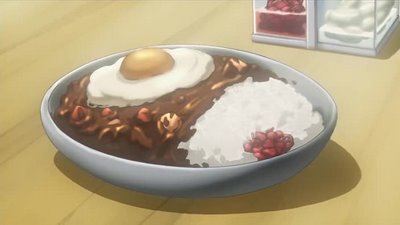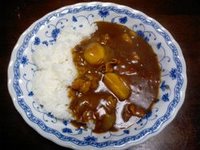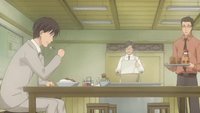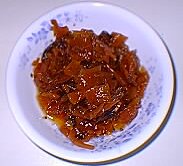Food-spotting v.3 =p~
~ G o t . k a r ē ? ;) ~
(from top: Kaoru's karē rice with fukujinzuke, rakkyo and tamago; karē rice RL; Kaoru dining ^_^; rakkyo; traditional red fukujinzuke; orange fukujinzuke and fukujinzuke without additives)
In HachiKuro II 12, Kaoru sees the light and celebrates with his father's celebated karē raisu, or rice with Japanese curry, which is one of the most popular dishes in Japan. There are three forms Japanese curry is commonly served in: karē raisu, karē udon and karē-pan. The fact that curry is very easy to make compared to many other Japanese dishes is one of the reasons for it's popularity in Japan. It can be made from a ready-made curry sauce mix, or roux (カレールー), in under an hour! Mixes come in the form of a sauce mix block or in powder form (which can be turned into curry gravy by adding water).
Japanese karē is usually thicker, sweeter and not as hot as the Indian version. A wide variety of vegetables and meats are used to make karē. The basic vegetables include potatoes, onions and carrots. For additional sweetness, grated apple or honey can be added. As for the meat, it is pork, beef and then chicken, in order of decreasing popularity. Pork is the most popular meat for curry in Tokyo by far, while beef is the most common in Osaka. Katsu-karē is a deep-fried pork cutlet in breadcrumbs with curry sauce. Surprisingly, in Japan, curry is categorised as a Western dish rather than an Asian dish. It may not be as surprising, however, when we realise that the reason is because curry was introduced to Japan during the Meiji era (1869 - 1913), at a time when the British colonised India.
How to make karē? Sauté chopped vegetables and meat in oil, margarine or butter; pick your poison choice. Once the onions have softened and the meat has browned, water is added and the mixture is brought to a boil. The ingredients are then simmered under low heat for about 20 minutes. If more tender meat is desired, then the simmering process can take longer. Finally, the curry mix is added, stirring frequently for about 5 minutes in order to thoroughly dissolve the mix. Et voila! Karē ready to be served!;D The karē is served in a large soup bowl, with white rice on the left side and karē on the right side, never to be poured on top of the rice. The preferred variety of rice is the sticky and round Japanese small grain, as opposed to the medium grain variety as per Indian and Chinese dishes. Usual garnishes are vegetables pickled in soy sauce as Fukujinzuke (福神漬け) or Rakkyo (辣韮), which are only eaten with curry dishes. The typical drink served with curry is water, and this is because no other drink compliments the strong taste of the curry as well.
And don't forget nabemono;D I blogged about it in an earlier entry=)
With Honey and Clover=) Chika Umino's culinary version of the union of her favourites: Spitz's Hachimitsu and Suga Shikao's Clover. I don't know how pancakes would taste with the clover, but the honey would predominate and taste mmm~~~
And this is from Harukanaru 19. Kotengu-chan is a-feasting on typical Japanese kaiseki cuisine! Looks like the standard ichijū-sansai (一汁三菜; "one soup, three sides") where you would have gohan, tsukemono and soup with three dishes, each employing a different cooking technique; raw fish (sashimi), or grilled, simmered (or "boiled" in translations from Japanese), steamed, deep fried, vinegared, or dressed dishes. Ichijū-sansai often finishes with tsukemono like umeboshi and green tea.We can see Kotengu-chan's gohan as his shushoku, with accompaniments including the likes of miso soup, tsukemono and okazu like the grilled fish. Okazu are usually designed "salty" to eat with shushoku in order to facilitate synergistic harmonization. Thus, in Japan, they are not usually expected to be eaten alone.
Kotengu-chan also demonstrates the typical serving style of kaiseki meals. Remember, Haruka is set in the traditional Japanese era. Japanese table settings has varied considerably over the centuries, depending primarily on the type of table which was common during a given era. Before the 19th century, diners were served meals atop small individual box tables (hakozen, 箱膳) or flat floor trays. By the beginning of the 20th century, larger low tables (chabudai, ちゃぶ台) that accommodated entire families grew popular. By the end of the 20th century, western style dining tables and chairs took over. In general, traditional table settings are based on the ichijū-sansai formula. Typically, five separate bowls and plates are set before the diner and nearest to the diner are the rice bowl on the left and the soup bowl on the right. Behind these are three flat plates to hold the three side dishes, one on the far back on the left side (on which a simmered dish might be served), one on the far back on the right side (on which a grilled dish might be served), and one in the center of the tray (on which boiled greens might be served). Tsukemono are often served to be eaten at the end of the meal, but are not counted as part of the side dishes.
Observe Kotengu-chan's similar style of kaiseki servings atop hakozen! So Haruka is pre-19th century Japan=) Cool eh? I love wiki!=D













0 Comments:
Post a Comment